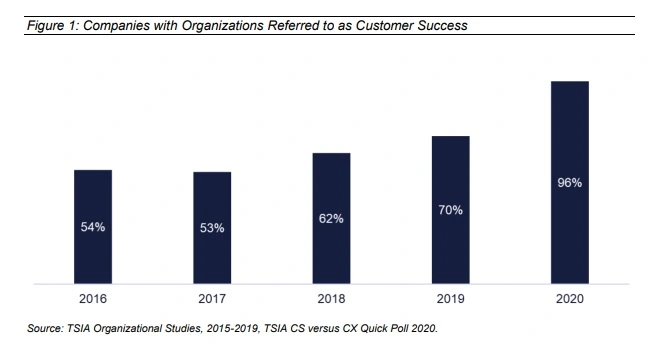Customer Success: How Does Your Business Define It?
B2B buyer expectations surrounding the customer experience are now at an all-time high—PwC found that 86% of buyers are willing to pay more for a product or service when the experience is better. As such, it’s critical for companies to define customer success, know what it means to their audiences, and implement strategies to help them achieve it.
The end goal? To keep customers happy and ensure they get maximum value from products and services—value that helps them solve problems and reach their goals. But for many organizations, implementing customer success as a standalone function with clear objectives is a new concept.
In this article, we’ll cover 4 meaningful ways to define customer success and implement a strategy that elevates it throughout the customer lifecycle.
Quick Takeaways:
- Customer success ensures customers achieve their desired outcomes from using your products and services.
- You can define customer success through customer outcomes, customer relationships, and value delivery.
- No matter what your approach, metrics should be used to achieve objective customer success measurement.
- Every company has their own unique definition of customer success, but can use proven approaches to defining and measuring it to achieve greater structure.
What is Customer Success?
Customer success is a strategic approach that focuses on ensuring customers achieve their desired outcomes through the use of a company’s products or services. It goes beyond simple customer satisfaction and aims to build long-lasting relationships that actively support customers throughout their journey.
At its core, customer success is about understanding the needs, goals, and challenges of each individual customer while maintaining company-wide best practices and standards around the experience you deliver.
It requires proactively guiding customers, providing personalized support, and ensuring they always see the value of their investment. Customer success teams work closely with customers, serving as trusted advisors and advocates, helping them overcome obstacles, and identifying opportunities for growth and success.
Effective customer success fosters loyalty, drives customer satisfaction, and ultimately leads to the success of both the customer and the business. It’s no surprise, then, that customer success is being prioritized at a greater rate now than ever before.
Today, 96% of companies have a dedicated team or department referred to as customer success.

In the next section, we’ll define 4 helpful ways to define customer success at your company and measure it in an objective, ongoing way.
4 Ways to Define Customer Success
Customer Outcomes
One way to define customer success is by customer outcomes. Identify your customers’ goals and track their progress toward achieving them. In many cases, there are specific goals that your products and services are built to help companies reach. You can categorize these goals and put reporting processes in place to measure them.
This requires close engagement with your customers to understand how they’re using your solutions and the progress they’re making over time. It’s helpful to put a framework in place for communicating about progress and monitoring KPIs along the way.
Outline this process and framework in your customer onboarding program so customers know from the start how and why goal tracking is a key part of your engagement.
Customer Relationships
For many customers, the idea of success is rooted in effective working relationships with their product/service providers. You can build strong customer relationships by anticipating customer needs, providing personalized guidance, and nurturing long-term partnerships that help them derive value from your offerings.
Invest in understanding your customers’ pain points, challenges, goals, and preferences, and offer tailored solutions and experiences to ensure satisfaction.
Value Delivery
Value is another key component of and way to define customer success. Focusing on the value your customers derive from your business—both in terms of your product/service offerings and the experience you provide—can help you understand their level of success long-term.
Measuring value requires making the connection between your company’s value proposition and customer pain points and needs. Tools like Strategyzer’s Value Proposition Canvas can help you define this connection tangibly and eliminate gaps to maximize value delivery.
Metrics-Driven Approach
No matter what approach you take to defining customer success, you need to make metrics a foundational part of the process. Your customer success metrics should be quantifiable so that you can objectively measure how well you’re facilitating it.
Some examples of important customer success metrics include:
- Customer Retention — Are you retaining your current customers at a high rate?
- Upselling and Cross-Selling — Happy, successful customers are more likely to make additional purchases from your business.
- Customer Lifetime Value — Successful customers will deliver value back to you by staying longer, purchasing more, and demonstrating positive outcomes from your business.
- Customer Satisfaction — Net Promoter Score (NPS) and similar metrics allow you to get direct feedback from customers.
Final Thoughts on Customer Success
Customer success technically measures how successful your customers are after using your products and services, but it also reflects back on you and your success as a provider.
When you excel at facilitating, measuring, and demonstrating customer success, you’re better able to retain customers and establish a solid brand reputation in your industry.
To recap, there are multiple ways to define customer success. They include:
- Customer Outcomes — Identifying customers’ goals and tracking their progress.
- Customer Relationships — Evaluating the quality of your relationships with current customers and working to optimize engagement.
- Value Delivery — Connecting your value proposition with customer needs and pain points to maximize value delivery.
- Metrics-Driven Measurement — Define customer success objectively using quantifiable metrics and KPIs.
While your specific definition of customer success may vary from other companies, embracing these approaches can help you build a structured framework around it. Over time, you’ll be better able to understand customers’ unique challenges, address their needs more quickly, and consistently deliver value that increases customer satisfaction.
Remember, it’s not just about satisfying customers—it’s about empowering them to succeed at every turn.
How Televerde Can Help
Televerde offers comprehensive customer experience solutions that support customers at every stage of their journey. Our solutions are rooted in best practices and built to be customized to the unique needs of every client. We aim to partner with you to provide the right expertise and technology tools to help you serve your customers well.
Get in touch with us today to learn more about how we can help you grow your business.


